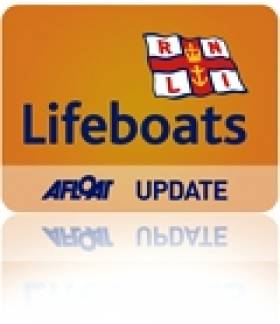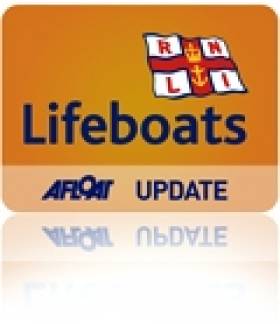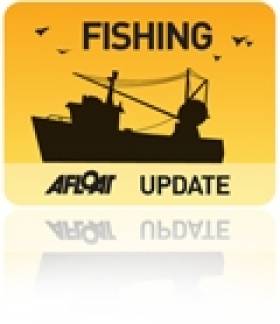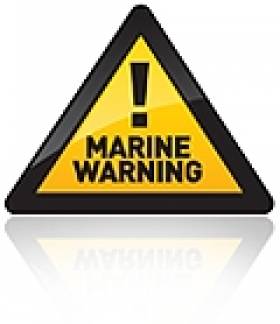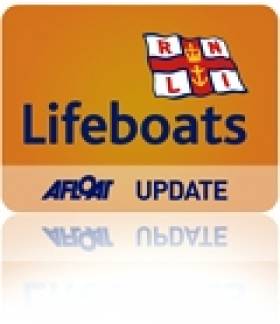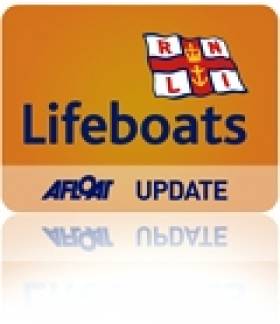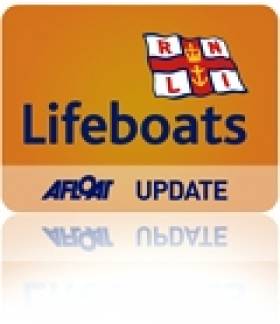Displaying items by tag: Kilmore Quay
Station To Station Challenge Raises More Than €2,000 For RNLI
#RNLI - Two men who embarked on the first RNLI Station to Station challenge between Bundoran and Arranmore last Saturday (6 April) completed the job in just under 12 hours - raising over €2,000 for both lifeboat stations in the process.
As per their plan reported previously on Afloat.ie, Niall Clancy and James McIntyre both set off from Bundoran Lifeboat Station just after 6am on Saturday morning – Clancy running and McIntyre cycling.
Clancy's route took him through Bundoran, Ballyshannon, Donegal town, Mountcharles, Frosses, Glenties, Gweebarra Bridge, Lettermacaward, Dungloe, Burtonport and finally Arranmore Island via a treadmill on the ferry!
He was joined on various legs of the journey by members of the Tir Chonaill Athletic Club who kept his spirits up on the 100km journey from station to station.
Meanwhile, McIntyre and his team from Mullaghmore Triathlon Club and Donegal Bay Cycling Club took off at the same time cycling as far as Lough Eske, where James then made the lonesome journey himself across the Bluestack Mountains, constantly keeping organisers informed of his progress via text message.
Down into Glenties and from there by bike to Portnoo where, with Bundoran RNLI crewman Killian O’Kelly, he kayaked the remaining 22km to Arranmore Island, where both he and Clancy were greeted by the lifeboat crew and the Arranmore Pipe Band.
Speaking on completion of the challenge at Arranmore RNLI Lifeboat Station, Clancy said: "It’s been a long but great day. The weather conditions couldn’t have been any better for both myself and James – though it was very cold this morning leaving Bundoran!
"I’m looking forward to a few weeks off training before I get back into it for the Athlone Half Ironman in August."
McIntyre added: "We’d both like to express our gratitude to everyone who supported us ahead of the challenge and today – particularly those who sponsored us and those who ran and cycled with us today, our support teams, our chefs, the RNLI crews and sponsors Ormston’s Mace Ballyshannon and All Sports Donegal Town."
Shane Smith, volunteer lifeboat press officer for Bundoran RNLI, said: "We are thrilled at the success of the challenge and delighted that over €2,000 has been raised for both stations.
"We are indebted to James and Niall for their selfless support of our charity and would like to thank them sincerely on behalf of both crews."
Elsewhere, a Wexford family who organised a sponsored swim in memory of a loved one and former volunteer have raised a whopping €5,000 for Kilmore Quay RNLI.
The Hayes family presented the cheque to the RNLI at Kilmore Quay lifeboat station recently, funded by a sponsored swim on St Stephen’s Day organised by the family in memory of the late Paddy Hayes, who was a volunteer with the lifeboat.
Kilmore Quay Marina. Yacht & Boat Berths & Storage in Wexford
Kilmore Quay is located in the south east corner of Ireland. A small fishing village situated approximately 14 miles from the town of Wexford and 12 miles from Rosslare ferry port. Its 55 berthed marina, offers shelter from the elements as well as various on shore facilities. Kilmore Quay is a regular port of call for many cruising yachtsmen. With several nearby areas of either historical or natural significance accessible using local bike hire, Kilmore Quay is renowned for its 'green' approach to the environment.
Kilmore Quay, Wexford, Ireland
Tel: 00353 53 912 9955 Fax: 00353 53 912 9915
Email: [email protected]
www.wexford.ie
Kilmore Quay RNLI Tends to Fishing Vessel in Epic Callout
#RNLI - The volunteer lifeboat crew at Kilmore Quay RNLI in Co Wexford responded to an 11-hour callout yesterday morning (Sunday 10 March) involving a 23-metre fishing vessel that had got into difficulty 40 miles south of the harbour. See video of the operation below.
With a biting easterly wind, the lifeboat crew made their way just after 8am to the vessel, which had suffered machinery failure, and arrived on scene at 10.40am.
Establishing a tow between the lifeboat and the fishing vessel with five crew onboard, the two vessels made slow progress back to shore in worsening conditions.
Commenting on the long callout, Kilmore Quay RNLI volunteer lifeboat crew member Aidan Bates said: “It was a bad day for a callout yesterday but the fishing vessel needed our assistance and the weather was worsening by the hour. By the time we were returning with the boat under tow the winds were blowing gale force seven to eight and it was choppy enough.
"Thankfully everyone was safe and the lifeboat crew were able to return home after a long day at sea.”
Fisherman Defends Giveaway of Over-Quota Monkfish
#FISHING - A Wexford fisherman has defended the free giving away of monkfish to the public yesterday morning after exceeding an EU quota.
RTÉ News reports that Seamus O'Flaherty, owner of the trawler Saltees Quest, handed out the fish to hundreds of passers-by at Kilmore Quay rather than have the surplus catch thrown back into the water.
The vessel's skipper Jimmy Byrne defended the move as a protest against an EU rule that requires over-quota fish to be discarded at sea.
According to The Irish Times, officers with the Sea Fisheries Protection Authority, who observed the monkfish giveaway yesterday, have prepared a file for submission to the Director of Public Prosecution.
The authority said it found a large quantity of monkfish retained on the vessel which had been logged as having been discarded - and emphasised that catches landed that are not declared as discards are still counted against the national quota.
Byrne, meanwhile, described the practice of discards of dead fish as "crazy" especially when many people in Ireland are "going hungry".
He commented: “I have a certain quota of fish to catch and the monkfish end up getting caught. There’s more monkfish in Ireland than ever before. I can’t tell the monkfish not to go into the net."
The Irish Times has more on the story HERE.
Marine Notice: Undersea Cable Repairs Off Kilmore Quay
#MARINE WARNING - In its latest Marine Notice to mariners in the Irish Sea, the Department of Transport, Tourism and Sport (DTTAS) advises of cable repairs being carried out east of Kilmore Quay in Co Wexford.
Operations commenced yesterday 6 September and will continue till approximately next Thursday 13 September, subject to the weather. The works will be undertaken by C/S Peter Faber (call sign FLEV).
During repairs the vessel will be links to the seabed by the cable and will have poor manoeuvrability. This will be signalled with shapes and/or lights as required. The vessel will also broadcast regular safety messages to give details of activity and position.
All vessens in the area, especially those engaged in fishing, are requested to give a wide berth, and not to pass between the repair vessel and the shore.
Full details, including co-ordinates, are included in Marine Notice No 48 of 2012, a PDF of which is available to read or download HERE.
Celtic Link Ferries First Ferry Goes to the Breakers
Launched as the Stena Tranporter, the career of the 16,000 tonnes has spanned over three decades in which the 151m vessel changed through several owners and subsequent vessel renamings.
It was when she served under the name Baltic Ferry, that her most notable career took place in 1982 during her wartime deployment as part of the
Falklands Islands Task Force. The 151m vessel was requisitioned by the British Ministry of Defence which saw the ship engaged in military operations when RAF Harrier Jump-Jet aircraft transferred store supplies from the deck of the ship as part of the war-effort in the South Atlantic Ocean.
In 2001 the vessel undertook ferry operations to Ireland as the European Diplomat on the Dublin-Liverpool route for the P&O (Irish Sea) route network. The following year she was transferred on the direct route to France until P&O pulled the plug on the continental service in December 2004, leaving Irish Ferries as the sole operator.
It was not until February 2005 that the route resumed service but this time under new owners Celtic Link Ferries. The O'Flaherty brothers, owners of a large fishing fleet in Kilmore Quay purchased the vessel and renamed her Diplomat. See PHOTO.
For the next four years she built up a steady customer loyalty between freight-hauliers drivers and car-only accompanying passengers who were accommodated in the ship which had a limited passenger certificate for 114 passengers. In addition she had a license to transport livestock.
Currently Celtic Link Ferries operate the ferry Norman Voyager but the 800-passenger / 200-car ro-pax vessel will only remain on the route until an October debut of a larger sistership the Cartour Beta.
The vessel is running this season between Italy and Sicily and with an added deck the 27,552 tonnes vessel has an increased capacity for passengers, cars and enhanced range of facilities. Recently the company had run a competition to name the new vessel which is to begin a five-year charter on the service between Wexford and Normandy.
- Wexford
- irish sea
- Diplomat
- Celtic Link Ferries
- Kilmore Quay
- Stena Rederi
- Marine Express
- RosslareCherbourg
- Norman Voyager
- Ports and Shipping News
- Normandy
- RoPax
- DublinLiverpool
- P&O (Irish Sea)
- Ferry news
- Cartour Beta
- Irish Sea Ferries
- Stena Transporter
- Baltic Ferry
- European Diplomat
- O'Flaherty Brothers
- Falklands Islands Task Force
- Hyundai Heavy Industries
- Freighthauliers
- Livestock
- RAF
- Harrier JumpJets
Crippled Sea Angling Boat Not So Crafty
Three anglers were recovered by the Kilmore Quay lifeboat last weekend after an engine failure on their vessel close to the Saltee Islands.
SAR Ireland reports that three males were on board the cheekily named Crafty Bitch on a fishing expedition when they got into difficulty.
They were forced to raise the alarm by phone as there was no VHF radio on board. The absence of radio and GPS made locating the vessel "very difficult", but the boat was eventually found after some delay and towed to port. All on board were wearing lifejackets.
Boat anglers are reminded to ensure they have at a bare minimum a VHF radio and GPS locator on board, as mobile phone signals can be unreliable offshore.
First Rescue for Kilmore's Tamar Lifeboat
Along with Coxswain Eugene Kehoe, lifeboat mechanic Brian Kehoe and two Kilmore Quay lifeboat crew were Divisional Inspector Gareth Morrison and Divisional Engineer David Murrin, who also took part in the callout. The Tamar is currently at sea every day for training to ensure all the volunteer crew members are fully trained on the new lifeboat.
Commenting on the first callout for the Tamar Deputy Divisional Inspector Gareth Morrison said, " The new lifeboat performed superbly. The extra speed in responding to callouts along with the improved radio direction finding equipment helped us locate the casualty vessel very quickly. On a bad night and in challenging conditions this will make a huge difference for the lifeboat volunteers."
Over fifty percent of Kilmore Quay's callouts are to fishing vessels. The new Tamar class lifeboat is 16.3 metres in length with a maximum speed of 25 knots compared to the 14.3 metres of the Tyne class lifeboat stationed at Kilmore Quay, which has a maximum speed of 18 knots. The lifeboat is self-righting and is fitted with an integrated electronics Systems and Information Management System, which allows the lifeboat crew to monitor, operate and control many of the boats systems from shock mitigating seats.
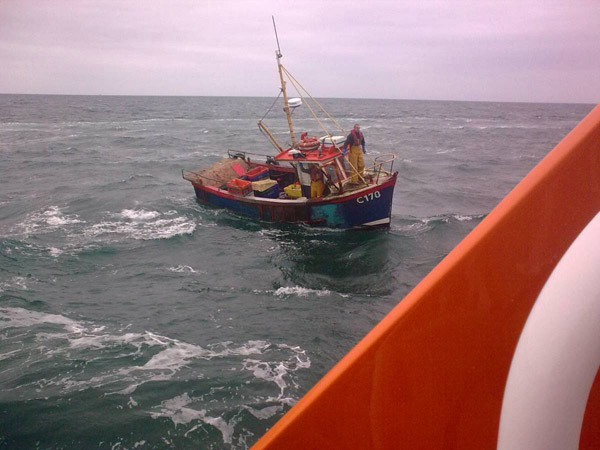
Photo: courtesy of Kilmore Quay RNLI
The Tamar Arrives!... At Kilmore Quay
The lifeboat was funded by a legacy from Mrs Mary Weeks from Surrey in England who passed away in 2006. Mrs Weeks met her husband while on a cruise off the west coast of Scotland on a boat named Killarney.

The RNLB Killarney on her maiden arrival yesterday to Kilmore Quay, Co. Wexford.
She also has a strong RNLI connection through her maiden name Distin. Mrs Weeks was related to the Coxswain of Salcombe lifeboat Samuel Distin and to Albert Distin. Both men lost their lives in the Salcombe lifeboat disaster of 1916.
The lifeboat hull was moulded by the RNLI and fitted out in Plymouth under RNLI supervision. Lifeboat crewmembers based in Kilmore Quay have undertaken comprehensive training at the lifeboat college in Poole and onboard the Tamar class lifeboat in preparation for their new arrival.
The new lifeboat is not expected to go on service until later in the month and the next few weeks will be spent training the rest of the lifeboat crew on the new boat. RNLI Deputy Divisional Inspector Gareth Morrison said, " This is a huge day for the RNLI in Ireland. The arrival of any lifeboat is a great celebration for a community but when it is the first of a new class of lifeboat the excitement is even greater.
The Kilmore Quay lifeboat crew have been looking forward to this day for a long time. Their last lifeboat the Famous Grouse rescued over 300 people since 2004 and this lifeboat station has had many challenging rescues in its history. I wish them the very best of luck with their new lifeboat, may she have many successful years ahead of her." Kilmore Quay lifeboat Coxswain Eugene Kehoe added, "It's a proud day for Kilmore Quay.

The crew of the RNLB Killarney
A new lifeboat is a tremendous gift and we will take very good care of it. We are very grateful to the donor who by leaving this legacy to the RNLI has provided a lifeboat that will go on to save many lives at sea.
On a bad night miles out to sea it is good to know that we have a state of the art lifeboat and a highly trained lifeboat crew to respond to every situation." The new Tamar class lifeboat is 16.3 metres in length with a maximum speed of 25 knots compared to the 14.3 metres of the current Tyne class lifeboat stationed at Kilmore Quay, which has a maximum speed of 18 knots.
The lifeboat is self-righting and is fitted with an integrated electronics Systems and Information Management System, which allows the lifeboat crew to monitor, operate and control many of the boats systems from shock mitigating seats. The Tamar also carries a Y boat (an inflatable daughter boat) which is housed under the aft deck and deployed from a hinged door in the transom. The lifeboat has room for 44 survivors. It will replace the current Kilmore Quay Tyne class lifeboat The Famous Grouse, which will be retired to the RNLI relief lifeboat fleet.
Related Safety posts
RNLI Lifeboats in Ireland
Safety News
Rescue News from RNLI Lifeboats in Ireland
Coast Guard News from Ireland
Water Safety News from Ireland
Marine Casualty Investigation Board News
Marine Warnings
First 'Tamar' Lifeboat Arrives at Kilmore Quay on Wednesday
The RNLI's new Tamar class all weather lifeboat will arrive at Kilmore Quay in County Wexford next Wednesday (13 October 2010) at 5pm. This €3 million lifeboat will be the first of its class to be based at an Irish lifeboat station. It is the most modern and technically advanced lifeboat in the RNLI fleet.
The new lifeboat, which is to be named Killarney, will undertake a five day passage from Poole in England, calling at lifeboat stations at the Channel Islands, Fowey, Padstow and Fishguard before arriving it its new home at the RNLI Kilmore Quay lifeboat station next Wednesday.
The lifeboat hull was moulded by the RNLI and fitted out in Plymouth under RNLI supervision. Lifeboat crewmembers based in Kilmore Quay have undertaken comprehensive training at the lifeboat college in Poole and on passage onboard the Tamar class lifeboat in preparation for their new arrival.
The new Tamar class lifeboat is 16.3 metres in length with a maximum speed of 25 knots compared to the 14.3 metres of the current Tyne class lifeboat stationed at Kilmore Quay, which has a maximum speed of 18 knots. The lifeboat is self-righting and is fitted with an integrated electronics Systems and Information Management System, which allows the lifeboat crew to monitor, operate and control many of the boats systems from shock mitigating seats.
The Tamar also carries a Y boat (an inflatable daughter boat) which is housed under the aft deck and deployed from a hinged door in the transom. The lifeboat has room for 44 survivors. It will replace the current Kilmore Quay Tyne class lifeboat The Famous Grouse, which will be retired to the RNLI relief lifeboat fleet. The €3 million lifeboat has been funded from a legacy.
All are welcome to attend. The RNLI is inviting everyone interested to see the new lifeboat's arrival into Kilmore Quay Harbour to be in place before 5pm.
Tamar Arrival in Ireland
Event: First Tamar class lifeboat in Ireland to arrive at Kilmore Quay RNLI Lifeboat Station in County Wexford
Date: Wednesday 13 October 2010Time: 5pm at Kilmore Quay harbour in County Wexford
Related Safety posts
RNLI Lifeboats in Ireland
Safety News
Rescue News from RNLI Lifeboats in Ireland
Coast Guard News from Ireland
Water Safety News from Ireland
Marine Casualty Investigation Board News
Marine Warnings


























